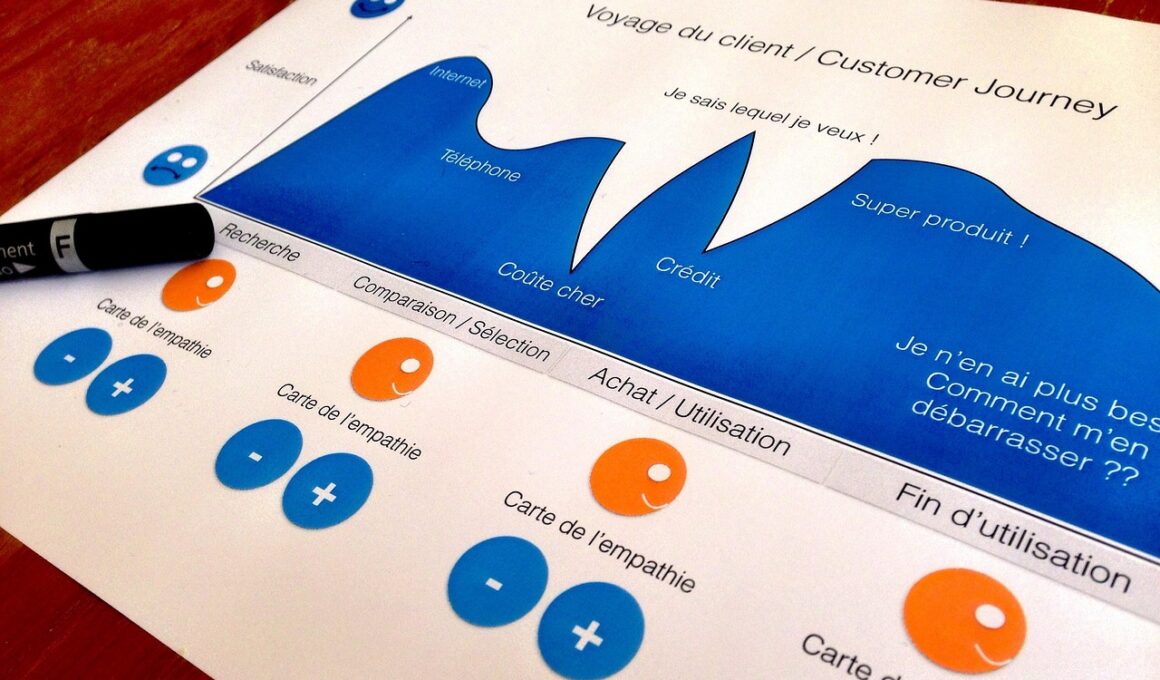Design Thinking and Customer Journey Mapping in Marketing
In today’s rapidly evolving business landscape, understanding the customer journey is paramount for effective marketing strategies. Customer journey mapping helps businesses visualize the complete experience of their consumers as they engage with a brand. The insight gained through this mapping process allows organizations to identify pain points and opportunities for enhancement throughout the customer experience. By incorporating design thinking into this process, businesses can foster a deeper empathy and understanding of consumer needs and behaviors. Design thinking emphasizes creative problem-solving, focusing on innovation through user-centered solutions. By combining these two powerful frameworks, organizations can align their strategies more effectively with customer expectations. To enhance the overall journey, teams can employ various techniques, such as brainstorming sessions and prototyping. These methodologies spark not only innovation but also collaboration within the marketing teams. The ultimate objective is to create a seamless, engaging experience for the consumers, leading to increased satisfaction and loyalty. As brands begin to embrace these practices, they gain a considerable competitive edge in meeting and exceeding consumer expectations, setting themselves apart from rivals in today’s marketplace.
The process of customer journey mapping typically starts with defining the stages of the journey that consumers undergo. These stages often include awareness, consideration, purchase, retention, and advocacy. Each stage represents a critical point at which customers form impressions about the brand’s values and offerings. To effectively chart this journey, marketers can utilize various tools, such as questionnaires and user interviews, to gather insights about customer experiences. Once enough data is collected, teams can create detailed personas representing their target audience. This representation helps ensure that marketing strategies resonate with actual consumer pain points and desires. Design thinking can enrich this analysis by encouraging teams to focus on storytelling. By mapping the customer journey in a narrative format, organizations can better visualize interactions, feelings, and motivations. Furthermore, incorporating customer feedback loops is essential during this mapping process. Continuous improvement is vital as preferences and behaviors evolve over time. Engaging with customers throughout their journey enables brands to refine their strategies and deliver tailored messages that resonate. The result is a more aligned and successful marketing initiative that fosters long-term relationships with customers.
Integrating Design Thinking into Marketing
Integrating design thinking into marketing strategies enhances the overall effectiveness of customer engagement methods. This approach encourages a culture of creativity and openness, essential qualities for developing innovative solutions. By focusing on empathy, collaboration, and experimentation, marketing teams can explore diverse perspectives that may lead to breakthrough ideas. One key aspect is ideation sessions, were marketers brainstorm ideas based on their customer insights. Such gatherings not only inspire collaborative thinking but also allow teams to reinforce the importance of understanding consumer needs. Moreover, prototyping in marketing helps visualize potential solutions before full-scale implementation. Through rapid testing and feedback collection, marketers can identify successful elements and refine their approach based on real-world responses. This iterative process significantly reduces the chances of investing resources into ineffective strategies. Additionally, leveraging customer feedback as a continuous input enhances the relevance of messaging and tactics. As consumers provide their thoughts and experiences within the journey, marketers can pivot accordingly. Ultimately, the fusion of design thinking with customer journey mapping results in marketing campaigns that are both creative and customer-centric, yielding greater overall impact on brand loyalty and success.
As businesses begin to recognize the value of customer journey mapping aligned with design thinking, they discover significant benefits. One of the primary advantages is the creation of enhanced customer experiences, driving not only satisfaction but also loyalty. An organization that genuinely understands its customers can tailor relevant marketing efforts, precisely addressing their needs and expectations. This level of personalization elevates the customer experience, allowing businesses to stand out amid fierce competition. Furthermore, by adopting a design thinking methodology, companies foster a culture of agility, adaptability, and responsiveness. Teams can quickly pivot their strategies based on changing consumer trends and preferences without prolonged delays. This agility empowers marketers to react promptly to market fluctuations, ensuring that they stay relevant. Innovations in technology also contribute to how teams map customer journeys. Integrating analytics and data-driven decision-making allows for the identification of key performance indicators (KPIs) that reveal valuable insights on consumer engagement. As organizations leverage this information, it’s possible to develop more targeted marketing strategies. Ultimately, this proactive approach contributes to a strong brand image and drives long-term success in a competitive landscape.
Technology’s Role in Customer Journey Mapping
Technological advancements play a crucial role in enhancing customer journey mapping by providing valuable tools and resources for businesses. Analytics platforms, social media monitoring tools, and customer relationship management (CRM) systems contribute to a comprehensive understanding of consumer interactions. By collecting data points across various channels, organizations can gain a holistic view of customer behavior. This helps expose trends that identify opportunities for meaningful contact and engagement. In addition, these tools facilitate segmentation of target audiences, enabling marketers to deliver personalized experiences tailored to specific demographics and psychographics. Leveraging artificial intelligence (AI) and machine learning algorithms can further refine customer journey mapping. These technologies can analyze vast amounts of data to uncover hidden insights and predict future behaviors. Marketers can, therefore, tailor their content and communication methods accordingly. Additionally, virtual reality (VR) and augmented reality (AR) technologies provide unique ways for customers to interact with brands. Brands can create immersive experiences that enhance consumer engagement while navigating their journey. As a result, technology strengthens the relationship between consumers and brands, aligning objectives and achieving higher satisfaction levels.
Moving forward, organizations must prioritize a customer-centric approach to ensure their marketing strategies remain effective. Emphasizing customer journey mapping as a key pillar of this framework is essential for success. With the landscape of consumer expectations continually changing, brands must adapt and evolve their strategies accordingly. By employing design thinking principles, businesses can remain agile, creativity-driven, and responsive to market shifts. Engaging employees in these processes fosters collaboration and encourages the generation of fresh ideas. Workshops and training sessions can refine team skills, focusing on customer empathy and user-centered design principles. Furthermore, businesses should actively seek real-time feedback and insights from their customers throughout their journeys. This feedback loop not only validates the mapping process but also allows organizations to continuously refine their approaches. By remaining in tune with customer needs, brands can cultivate deeper relationships, enhance loyalty, and improve business performance. The integration of design thinking within customer journey mapping paves the way for success. Ultimately, by adopting these practices, brands position themselves to thrive in a challenging and dynamic marketing landscape.
Conclusion
In conclusion, design thinking and customer journey mapping are essential tools for today’s B2C marketers. They enable brands to visualize the consumer experience comprehensively while fostering innovative approaches to problem-solving. By focusing on empathy and collaboration, and leveraging technology, organizations can develop marketing strategies that resonate with their audiences. This alignment not only drives customer satisfaction but also promotes lasting loyalty. The necessity for a customer-centric mindset is clear; brands must prioritize consumer needs in every aspect of their marketing efforts. By which case, the ability to adapt and evolve over time cannot be overstated. As the landscape of consumer expectations shifts, marketers who embrace these frameworks will excel in delivering powerful messages that resonate deeply. Moving forward, organizations can remain competitive by maintaining a commitment to advancing and refining their customer journey mapping efforts. Continuous growth and innovation will ultimately result in stronger brand identities and market positions. As the world of marketing and consumer behavior continues to evolve, the effective use of design thinking will undoubtedly shape the future of business interactions. Hence, the journey toward becoming more customer-centric is pivotal for success in today’s dynamic marketplace.
In summary, today’s B2C marketing environment demands the integration of innovative strategies like design thinking with meticulous customer journey mapping. By harnessing these approaches, companies can effectively address the complexities of consumer needs and preferences. The blend of creativity, empathy, and technological advancement serves to enhance the overall marketing efforts. Moreover, the ability to pivot swiftly based on actionable insights drives great success in achieving marketing objectives. As businesses continue this journey, the emphasis must be on cultivating stronger connections with consumers that will last beyond single transactions. A commitment to understanding the customer journey paves the way for superior experiences and better engagement. This evolving practice creates opportunities for brands to thrive amid competition and uncertainty. Therefore, the continuous embrace of both design thinking and customer journey mapping will equip marketers with the necessary tools for success. Developing innovative strategies ensures businesses remain ahead of the curve in meeting and exceeding customer expectations. With profound insights into consumer behavior, brands can create memorable experiences that resonate while fostering loyalty. As the market continues to change, organizations must remain adaptable in their strategies to maintain relevance and growth.


